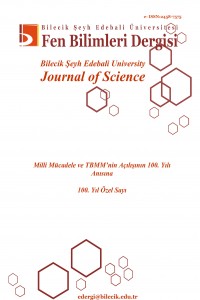A comparison between the performance of Weibull and Log-logistic Aging Models on Saccharomyces cerevisiae lifespan data
Öz
Empirical
lifespan datasets are often studied with the best-fitted mathematical model for
aging. In this study, we focus our attention to the budding yeast S. cerevisiae lifespan and the determination
of the best-fitted model of aging. We investigate the influence of model
selection in yeast lifespan datasets and the fitting outcomes of the
two-parameter Weibull (WE) and Log-logistic (LL) models of aging. Both of these
models are commonly studied and implemented in aging research. They show
similar tendency as a survival function that they correspond
to mortality rates that increase, and then decrease, with time. Studies so far
has been usually done with medflies,
Drosophila, house flies, flour beetles, and humans with these models. Different
than previous research, we focus our attention on the influence of fitting
results and calibrations on empirical lifespan data samples. As expected both
of the models could be used as a substitute of each other. However, we also find
WE model fits the yeast lifespan data significantly better than LL model with
an R2 = 0.86. This finding is
especially important in yeast aging study because of typically survival models
are applied and therefore one can see which model fits the yeast data best. In
this article, comparisons are done and
developed and the potential of the approach is demonstrated with a model
comparison of yeast replicative lifespan datasets of the laboratory BY4741 and
BY4742 wildtype reference strains. Our study highlights that interpreting model
fitting results of experimental lifespans should take model selection and
resulted variation into account.
Anahtar Kelimeler
the Weibull Model the Log-logistic Model survival analysis aging yeast
Kaynakça
- [1] Bennet S., “Log-Logistic Regression Models for Survival Data Author ( s ): Steve Bennett Published by : Wiley for the Royal Statistical Society Stable URL : http://www.jstor.org/stable/2347295 Log-logistic Regression Models for Survival Data,” J. R. Stat. Soc. Ser. C, vol. 32, no. 2, pp. 165–171, 1983.[2] Al-Shomrani A. A., Shawky A. I., Arif O. H., and Aslam M., “Log-logistic distribution for survival data analysis using MCMC,” Springerplus, vol. 5, no. 1, 2016.[3] Weitz J. S., and Fraser H. B., “Explaining mortality rate plateaus,” Proc. Natl. Acad. Sci., vol. 98, no. 26, pp. 15383–15386, 2002.[4] D. Wei et al., “Data Descriptor: Structural and functional brain scans from the cross-sectional Southwest University adult lifespan dataset,” Sci. Data, 2018.[5] Fire M. and Elovici Y., “Data Mining of Online Genealogy Datasets for Revealing Lifespan Patterns in Human Population,” ACM Trans. Intell. Syst. Technol., 2015.[6] Longo V. D., Shadel G. S., Kaeberlein M., and Kennedy B., “Replicative and chronological aging in saccharomyces cerevisiae,” Cell Metab., vol. 16, no. 1, pp. 18–31, 2012.[7] Carmona-Gutierrez S., Didac and Buttner, “The many ways to age for a single yeast cell,” Yeast, vol. 31, no. January, pp. 289–298, 2014.[8] P. Fabrizio et al., “Superoxide is a mediator of an altruistic aging program in Saccharomyces cerevisiae,” J. Cell Biol., vol. 166, no. 7, pp. 1055–1067, 2004.[9] Postnikoff S. D. L., Johnson J. E., and Tyler J. K., “The integrated stress response in budding yeast lifespan extension,” Microb. Cell, vol. 4, no. 11, pp. 368–375, 2017.[10] Korlakai Vinayak R., Kong W., Valiant G., Kakade S. M., and Allen †, “Maximum Likelihood Estimation for Learning Populations of Parameters,” 2019.[11] Lenart A., “The Gompertz distribution and Maximum Likelihood Estimation of its parameters - a revision,” MPDIR Work. Pap., vol. 49, no. 0, pp. 0–19, 2012.[12] Odell P. M., Anderson K. M., and Agostino R. B. D., “Maximum Likelihood Estimation for Interval-Censored Data Using a Weibull- Based Accelerated Failure Time Model,” Int. Biometric Soc., vol. 48, no. 3, pp. 951–959, 1992.[13] Rockette H., Antle C., and Klimko L. A., “Maximum likelihood estimation with the weibull model,” J. Am. Stat. Assoc., vol. 69, no. 345, pp. 246–249, 1974.[14] Hill Carter T., and Fomby, Maximum simulated likelihood methods and applications. Emerald Group Publishing, 2010.[15] deLeeuw J., “Introduction to Akaike (1973) Information Theory and an Extension of the Maximum Likelihood Principle,” no. 1973, pp. 599–609, 2011.[16] Cole S. R., Chu H., and Greenland S., “Maximum likelihood, profile likelihood, and penalized likelihood: A primer,” Am. J. Epidemiol., vol. 179, no. 2, pp. 252–260, 2014.[17] Jackson C. H., “flexsurv: a platform for flexible parametric survival modelling in R,” J. Stat. Softw. (in Press., no. Latimer 2013, 2015.[18] Wilson D. L., “A comparison of methods for estimating mortality parameters from survival data,” Mech. Ageing Dev., vol. 66, no. 3, pp. 269–281, 1993.[19] Güven E., Akçay S., and Qin H., “The Effect of Gaussian Noise on Maximum Likelihood Fitting of Gompertz and Weibull Mortality Models with Yeast Lifespan Data,” Exp. Aging Res., 2019.[20] Juckett D. A. and Rosenberg B., “Comparison of the Gompertz and Weibull functions as descriptors for human mortality distributions and their intersections,” Mech. Ageing Dev., vol. 69, no. 1–2, pp. 1–31, 1993.[21] Lestienne R., “On the thermodynamical and biological interpretation of the Gompertzian mortality rate distribution.,” Mech. Ageing Dev., vol. 42, no. 3, pp. 197–214, Mar. 1988.
Ayrıntılar
| Birincil Dil | İngilizce |
|---|---|
| Bölüm | Makaleler |
| Yazarlar | |
| Yayımlanma Tarihi | 23 Mart 2020 |
| Gönderilme Tarihi | 2 Ağustos 2019 |
| Kabul Tarihi | 9 Ocak 2020 |
| Yayımlandığı Sayı | Yıl 2020 Cilt: 7 Sayı: 100. Yıl Özel Sayı |

